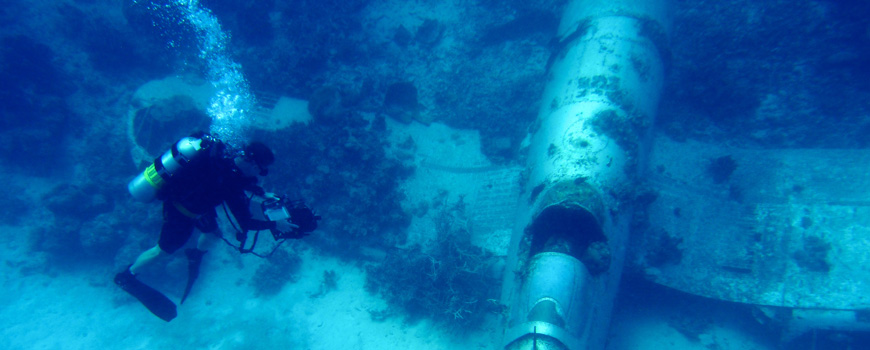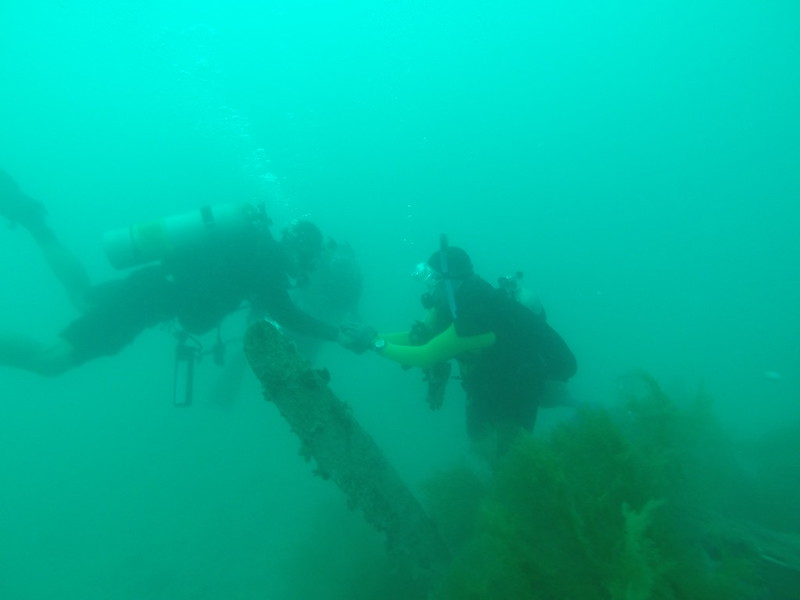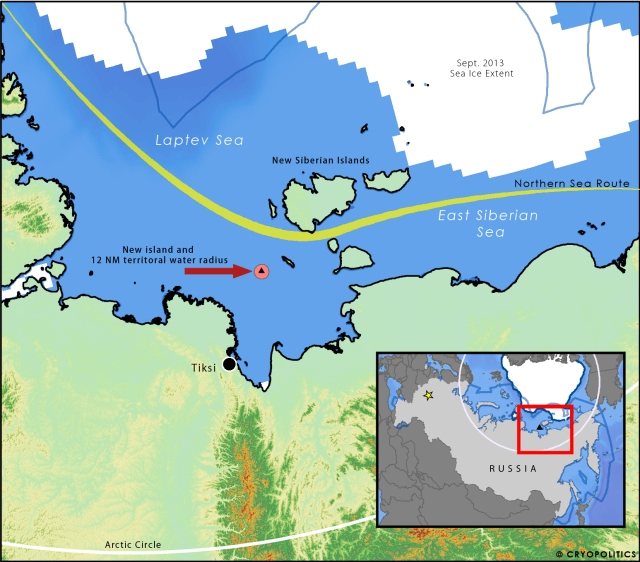Passion meets technology in the search for downed aircraft in the South Pacific.
The BentProp Project is a group of volunteers who search for and help repatriate missing World War II Airmen.
Their searches were long and arduous until they enlisted the scientific know-how of Scripps Institution of Oceanography-UCSD and The University of Delaware.
What they find is truly inspiring.
An endeavor to employ a suite of oceanographic research instruments
to find downed World War II aircraft and the remains of troops listed as
missing in action for nearly 70 years are the subject of a
film by camera maker GoPro and the CBS news magazine “60 Minutes.”
Supported by a grant from the Office of Naval Research, Scripps
Institution of Oceanography, UC San Diego, oceanographer Eric Terrill
and colleagues from the
University of Delaware have teamed up with the
nonprofit group
BentProp Project in a public-private partnership to
bring closure to families that have waited for several generations for
final word on the fate of their loved ones.
At the same time, the
project provides a test bed for developing underwater search
technologies and methods, and is a platform for inspiring public
interest in science and engineering.
Palau islands with the Marine GeoGarage (NGA charts)
Earlier this year, the team logged a major success during a
month-long expedition in the Republic of
Palau, finding wreckage of two
U.S. aircraft that were associated with airmen that have been listed as
missing in action since World War II.
“This program has been a rewarding opportunity for the chance to
recognize the sacrifices our servicemen have paid and give back to
families who have lost loved ones,” said Terrill.
“It is rare in
scientific research to be involved in activities that will have direct
personal impacts; our participation and successes in this effort have
been humbling.”
Scripps Oceanography development engineer Evan Walsh flies a 3D Robotics hexacopter, used in the field as a sensor and image capturing platform.
BentProp’s effort is chronicled in a video released by
GoPro,
the camera company founded by UC San Diego alumnus Nick Woodman, and is
scheduled to be profiled in a future airing of “60 Minutes.”
“I applaud Scripps’s efforts, in conjunction with the
BentProp Project, University of Delaware, and GoPro, to help locate the remains
of our missing airmen and sailors,” said U.S. Representative Susan
Davis, a member of the House Armed Services Committee.
“We have a
responsibility to locate those who are missing and remain unaccounted
for, and return them home to their families and loved ones. As Congress
and the Department of Defense identify ways to more effectively locate
those who are missing in action, I hope we can look to creative
partnerships like this to bring closure to the families of these service
members.”
Since 2010, Terrill’s group has conducted oceanographic research in
the waters around Palau.
The islands that make up the small country were
the locale of a Japanese airfield during World War II. The strategic
Pacific position was also the site of several World War II dogfights,
aerial bombing and ground missions.
One of World War II’s bloodiest
battles was the landing at
Peleliu, a 1944 attack ordered by Gen.
Douglas MacArthur that ended in the deaths of 10,000 Japanese and 1,700
American troops.
Terrill’s group at Scripps Oceanography, the Coastal Ocean Research
and Development Center, has been deploying sensors in Palau to measure
temperatures, waves, currents, and sea level to better understand the
influence of the complex terrain on circulation.
The autonomous
underwater vehicles (AUVs) equipped with high-frequency sonar allowed
rapid surveys of large areas and provided a means to map the distinctive
seafloor’s contours that challenge modern forecast models.
Before
collaborating with BentProp, Terrill’s initial interests had more to do
with understanding mapping the reefs, ocean circulation and phenomena
such as sea-level rise – a matter of special interest to low-lying
western Pacific island nations.
Scattered among the lagoon waters and coral reefs surrounding Palau’s
island chain, and concealed within its dense mangrove forests, are
believed to be several dozen U.S. and Japanese aircraft and the remains
of perhaps as many as 80 U.S. airmen.
The mission began in 2012 after an introduction by local scientist
Pat Colin of the Coral Reef Research Foundation at a popular
meeting spot in Koror, Palau’s main city, and brought together Terrill’s
science mission with that of Pat Scannon, BentProp’s founder.
Scannon
had become interested in searching for MIAs after a 1993 dive trip
through the country’s islands.
“I was told there’s a really cool guy over there with all these cool
toys,” said Scannon in reference to Terrill.
“This really is a
partnership where there’s integration with our search mission with
Eric’s technological and oceanographic capabilities. It’s a two way
street. We’re able to advance what we’re trying to do in terms of our
search and they’re learning more about the technology aspects of working
in interesting and complex settings.”
Scripps engineer Shannon Scott investigates wreckage off Pacific Island nation of Palau
After the chance meeting, Terrill and his colleague Mark Moline from
the University of Delaware approached the Office of Naval Research
to develop a two-year pilot program that would include both Science,
Technology, Engineering and Mathematics (STEM) outreach and demonstrate
the utility of the Navy’s investment in unmanned underwater systems to
the national mission of searching for MIAs.
Project RECOVER was
formed as a means to formalize this partnership. STEM outreach was
extended to include a high school robotics team from Stockbridge,
Michigan who built their own remotely operated vehicle to survey wrecks.
BentProp and Terrill’s group have worked closely since the meeting,
with the organization frequently visiting the Scripps campus to go over
recently uncovered historical information that could aid future
searches.
Scannon describes a year of BentProp activity as one month of
on-scene searching and 11 months of data collection, whether scientific
or historic.
Possible trajectories of lost aircraft
UC San Diego aeronautical engineers developed statistical models of the flight trajectory for a missing B24 aircraft.
A student group of aeronautical engineering students ran what are known as Bayesian models while researchers from Scripps Institution of Oceanography and University of Delaware were surveying in Palau, and received revised probability maps for areas where the plane might be located based upon data oceanographers had collected.
The plane remains missing and is a focus of planning for a 2015 mission.
The instruments used by Terrill and Moline turned out to be perfect
for the kind of seafloor surveys needed to search for missing aircraft
in the lagoon waters of Palau and complemented BentProp’s exhaustive
review of World War II text and photo archives.
These historical
records, along with interviews of veterans, have proven invaluable for
providing clues to guide the searches.
Scripps’s own history of collaboration with the U.S. military extends
back before World War II.
During the war, Scripps researchers worked
closely with military planners to create surf and swell forecasts that
helped time amphibious landings and lent other expertise that gave the
Allies an advantage in warfare at sea.
“I couldn’t be prouder or more impressed with the Scripps team and
the partnerships we established and traveled to Palau with. The
diversity of skills we bring to this problem is unprecedented and spans
almost all fields of science and engineering. The small team
environment has allowed us to be remarkably nimble and productive in our
field work, and the entire nation of Palau has been fantastic to work,”
said Terrill.
“Scripps participation in this effort is full circle to
our institution’s research efforts to support Allied troops 70 years
ago.”
The missing Navy Hellcat Fighter plane that was discovered amid coral heads in Palau back in March.
(Photo: Mark Moline/University of Delaware )
The AUVs used by the groups, known as Remote Environmental Monitoring
Units (
REMUS) were actually developed by colleagues of Terrill and
Moline’s at Woods Hole Oceanographic Institution, but now commercially
manufactured by a spin-off company called Hydroid.
The systems are
equipped with sidescan sonar that can image the seafloor with great
detail.
Scripps engineers Billy Middleton, Myles Syverud, and Andy
Nager are experts at running the vehicles, and adept at rapidly
analyzing the data for wrecks – distinguishing metal debris from natural
seafloor relief.
Multi-rotor aerial systems deployed by Terrill’s
group are used to conduct aerial surveys over land and shorelines and
also provide a bird’s eye view of dense island foliage that enables
detection of wreckage.
This year, Scripps engineer Evan Walsh integrated
an infrared camera into the aerial system to provide aerial maps of
temperature differences.
A huge challenge to all the new technology is
the fusing of information.
Fortunately, said Terrill, Scripps computer
scientist Paul Reuter remains at the cutting edge of handling and
visualizing large data sets and integrating 70-year-old reconnaissance
photographs into the search analysis.
Inexpensive GoPro cameras are mounted to nearly all the science
instruments used by Terrill’s group, contributing directly to research
and providing the raw material for video outreach, which have been
incorporated into Project RECOVER.
Scripps engineer Shannon Scott even
integrates the cameras with the handheld diver sonar he uses when
reconnoitering underwater targets revealed by the vehicle surveys.
Scripps oceanographer Eric Terrill uses the SharkMarine Navigator, a handheld scanning sonar unit, during dives to locate potential targets in search of downed WWII aircraft.
GoPro cameramen filmed a portion of search operations and used the searchers’ own footage to create the 13-minute film “
Palau – Searching for Heroes.”
“We are honored that GoPro is part of this effort to search for and
recover missing airmen from World War II. We are always interested in
learning how our cameras are used for more than just documentation, to
see and learn how the GoPros are used as a tool to complement the sonar
technology is very inspiring,” said GoPro Director of Global Media
Relations Rick Loughery.
“Personally, this was an amazing experience
for me and I am proud that GoPro is able to support it and hope that our
video will create more awareness for the noble efforts put forth by the
BentProp Project, Scripps Oceanography, and the University of
Delaware.”
“It’s something very special that feels nearly surreal,” said Travis
Schramek, a Ph.D. student in Terrill’s lab who has taken part in the
search fieldwork and whose footage appears in the film.
“These problems
are not easily solved and can get pushed by the wayside, but this shows
that when people get together, they’re capable of accomplishing
something truly unique and people like that coalesce around places like
Scripps and the University of Delaware.”
Scripps oceanographer Eric Terrill and BentProp founder Pat Scannon moments after finding the main fuselage of a TBM Avenger lost 70 years ago during a bombing mission near Palau.
The wreck sits in 100 feet of water.
Other UC San Diego researchers joined the search in different ways.
Terrill collaborates with Mark Anderson of UC San Diego’s Department of
Aeronautical Engineering.
Anderson has a background in aeronautics,
flight trajectories, and statistics and was asked by Terrill to help
with developing a predictive model for a missing B-24 that remains to be
found.
A group of engineering students was enlisted to run what are
known as Bayesian models, using the best-known historic information
collected by BentProp over the last decade.
During the most recent
expedition, the probability maps for areas where the plane might be
located were routinely updated by the students (during their Spring
break) based upon data collected by Terrill’s group that was relayed to
them in San Diego.
The plane remains missing, and teams remain focused
on planning for a 2015 mission to complete their search.
Satellite image of main island group of Palau, with high-resolution light detection and ranging (LIDAR) bathymetric data obtained from the Naval Oceanographic Office.
Due to the extreme changes in bathymetry present in the lagoon waters, the LIDAR data is invaluable for mission planning of the unmanned underwater vehicle.
LIDAR data is also used for science projects including the forecasting of impacts of sea level rise on the reefs, mangroves, and local infrastructure.
Further help comes from the U.S. Navy, which provided light detection
and ranging (LIDAR) imagery for the search area.
The data, originally
created to create navigational maps, offer more detail on seafloor
features to guide future search missions and was used previously by
CORDC to assess sea-level rise impacts. The raw data has been
re-examined to look for topographic anomalies (wrecks) and has been
invaluable in mission planning for the underwater systems.
World War II aircraft such as TBM Avengers are among those recently found by nonprofit organization BentProp with help from Scripps Oceanography, the University of Delaware, UC San Diego, and the Navy.
In the case of the two planes found last spring, a TBM Avenger and an
F6F Hellcat, BentProp had been searching for them for nearly 10 years.
It took the REMUS-mounted instruments to see them at a depth of more
than 100 feet, hidden from plain view by the persistent murk of the
seafloor.
“There was the pre-Scripps era and the post-Scripps era,” said
Scannon.
“Our technology before Scripps was scuba gear and that has
extreme limitations especially because what we’re looking for lies below
100 feet. We could have gone by those planes two or three times without
even seeing them.”
The University of Delaware’s autonomous underwater vehicle, which uses sidescan sonar to scan the bottom of the ocean floor, including ridges of sand, deep valleys and corals.
The combination of the sonar technology and GoPro cameras enable the team to more effectively identifying potential targets.
(Photo: Mark Moline/University of Delaware )
In a story propelled in large part by chance, one of the two
warplanes discovered earlier this year turned out to have personal
connection to Terrill.
It was constructed in a Tarrytown, N.Y., General
Motors factory at which Terrill’s grandfather served as the paint and
body manager.
Terrill was unaware of the family connection to plane
production until talking with his father a few days prior to departing
for the last expedition, and learning that during the wartime effort,
the Navy called upon General Motors to support Grumman in the production
of the much-needed and versatile torpedo bomber.
When he dived to the
wreckage, he became the second person in his family to study the plane,
separated by a span of more than seven decades.
“With details from the missing plane’s After Action Reports recorded
during the war, we were able to place the planes production in the same
plant that my grandfather worked as the paint and body manager, I
learned he would have inspected all bodywork coming from the plant.”
BentProp gave detailed information about the two discovered planes
and possible links to airmen listed as missing in action to the
Department of Defense’s Joint POW/MIA Accounting Command, which may
undertake recovery efforts next year.
When JPAC’s work is complete,
these will be the first successful recoveries involving this newly
formed partnership.
If remains are returned to loved ones, and if
Scannon is present for the encounter, he has an idea of what to expect
from his previous experiences.
“An MIA family never forgets,” he said.
“When I walk into a home,
there’s often still a shrine. A second- or third-generation family
member can still feel the loss very strongly because they never knew
them.”
Links :
- CNET : How BentProp and undersea robots found long-lost WWII bombers
- Washington Post : How drones and GoPro cameras are helping recover lost WWII planes
- Last flight home , the flm of the story of the B-24 crew













